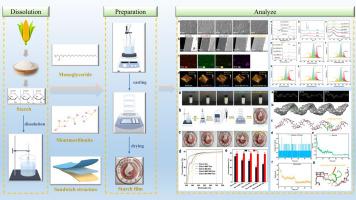Tailoring starch-based films with monoglyceride and montmorillonite: Molecular interactions, hydrophobicity, and barrier properties
IF 9.8
1区 农林科学
Q1 CHEMISTRY, APPLIED
引用次数: 0
Abstract
Herein, a novel multilayer starch-based film was engineered through the strategic incorporation of monoglyceride (MG) and montmorillonite (MMT) to simultaneously enhance hydrophobicity and barrier properties. Molecular dynamics (MD) simulations elucidated the non-covalent interactions within the film matrix. Characterization by scanning electron microscopy (SEM), atomic force microscopy (AFM), and UV–visible spectroscopy revealed uniform film formation and well-controlled surface roughness. The resulting starch-MMT-MG composite exhibited excellent optical clarity, with visible light transmittance of 77.78 % at 700 nm and strong UV-shielding capacity (40.88 % at 300 nm). As hypothesized, positioning MMT in the middle layer and applying MG as a top coating yielded a film with uniform formation and controlled surface roughness. This configuration led to the film's superior water resistance, as evidenced by the lowest water solubility (WS) of 15.83 %, the highest contact angle (CA) of 109.36°, and a reduced water vapor permeability (WVP) of 0.78 × 10−10 g·m·m−2·s−1·Pa−1. Mechanical testing further demonstrated the film's robustness and flexibility, showing a Young's modulus of 128.24 MPa, tensile strength of 16.58 MPa, and elongation at break of 58.66 %. Consistent with these experimental findings, MD simulations verified stable hydrogen bonding between starch and MG, highlighting their strong molecular compatibility. Collectively, these results underscore the promise of starch-MMT-MG films as multifunctional, sustainable materials for advanced packaging applications.


用单甘油酯和蒙脱土裁剪淀粉基薄膜:分子相互作用,疏水性和屏障性能
本文通过单甘油酯(MG)和蒙脱土(MMT)的战略性掺入,设计了一种新型多层淀粉基膜,同时增强了疏水性和屏障性能。采用分子动力学(MD)模拟来阐明控制薄膜基质的非共价相互作用。通过扫描电子显微镜(SEM)、原子力显微镜(AFM)和紫外可见光谱进行表征,发现薄膜形成均匀,表面粗糙度精细调节。制备的淀粉- mmt - mg复合材料具有优异的光学清晰度,在700 nm处的可见光透过率为77.78 %,在300 nm处具有较强的紫外线屏蔽能力(40.88 %)。正如假设的那样,在中间层中集成MMT,并应用MG作为顶部涂层,导致薄膜形成均匀且表面粗糙度可控。这种结构使膜具有优异的耐水性,最低水溶性(WS)为15.83 %,最大接触角(CA)为109.36°,水蒸气渗透率(WVP)降低0.78 × 10−10 g·m·m−2·s−1·Pa−1。力学测试进一步证明了该薄膜的鲁棒性和柔韧性,杨氏模量为128.24 MPa,抗拉强度为16.58 MPa,最大断裂伸长率为58.66 %。与实验结果一致,MD模拟证实淀粉和MG之间形成了稳定的氢键,突出了它们较强的分子相容性。总的来说,这些结果强调了淀粉- mmt - mg薄膜作为先进包装应用的多功能、可持续材料的潜力。
本文章由计算机程序翻译,如有差异,请以英文原文为准。
求助全文
约1分钟内获得全文
求助全文
来源期刊

Food Chemistry
工程技术-食品科技
CiteScore
16.30
自引率
10.20%
发文量
3130
审稿时长
122 days
期刊介绍:
Food Chemistry publishes original research papers dealing with the advancement of the chemistry and biochemistry of foods or the analytical methods/ approach used. All papers should focus on the novelty of the research carried out.
 求助内容:
求助内容: 应助结果提醒方式:
应助结果提醒方式:


